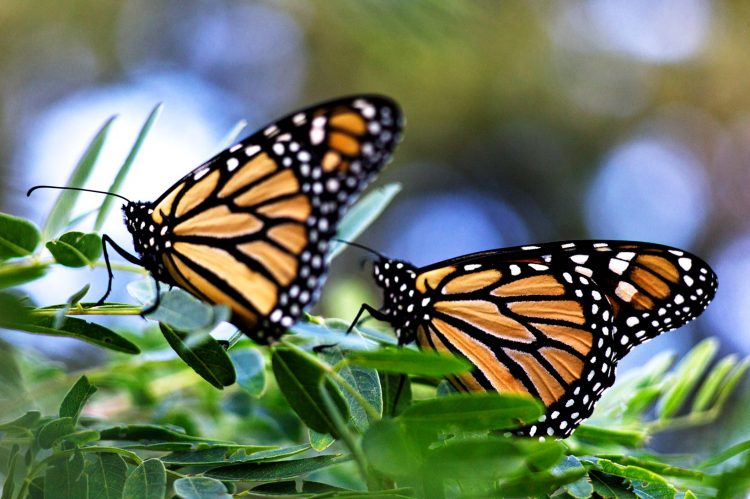Here are three plants in the Milkweed family. Native Milkweed on the left and two other Butterfly bushes on the right.
There is no doubt that the Monarch Butterfly’s numbers are greatly reduced. A recent article in the Huffington Post reported their winter home in Mexico now covers just 1.65 Acres. This is down from 44.5 Acres in 1996. What was once a frequent sight and symbol of summer for much of the United States, now needs our help due to habitat loss and pesticide overuse. Having spent years observing a number of different milkweed species and the Monarch’s interactions with them, I take a look at the various Milkweed that are acceptable to their larvae here in Southern Minnesota.
It is important to understand the relationship between the Monarch Butterfly and the milkweed plant. Milkweed contain natural toxins called Cardenolides which are a cardiac glycoside. These toxins affect the heart of the predators that would prey on the butterfly or larvae. The Monarch larvae eat the leaves and sap of the milkweed and ingest the toxic cardenolides. The Monarch caterpillars are engineers of cardenolide consumption. They cut the veins of the Milkweed plant to reduce or change the flow of sap causing a safe dose for the growing caterpillar.
I am fortunate to have some native Common Milkweed (Asclepias syriaca) growing in my yard and I have taken care to provide it locations that it can flourish and provide habitat. The flowers of this native plant have an amazing smell when in bloom and the flowers directly outside my window fill the room with a pleasant fragrance similar to lilac. Of the species I have cultivated, Common Milkweed is tied for most desirable for Monarch eggs and larvae. However it seems to be the most toxic and some of the caterpillars don’t make it to the pupae stage.
The flowers of Common Milkweed (Asclepias syriaca) smell very nice and are an excellent source of pollen for the adult Monarch. While the leaves are a great source of food for the caterpillars.
Common Milkweed can be used in the landscape anywhere tall, full bodied plants are needed.
The second most popular milkweed with the Monarchs is the Swamp Milkweed (Asclepias Incarnata). These are another native species that were hybridized and cultivated for sale at landscaping and greenhouse stores. The leaves aren’t as wide as the common milkweed and the sap is less thick and milky. It seems that the Monarch caterpillars that consume these leaves appear healthier and more successful at building a chrysalis or cocoon. These plants come up year after year in the same location and their seeds spread quite easily. The flowers do not have a very noticeable smell but cover the plant and are an excellent source of pollen for butterflies, bees, and other insects.
Swamp Milkweed is not as tall as the common milkweed but is more bush like and filled with flowers.
Swamp Milkweed is a sort of Butterfly Bush that is attractive to many insects due to it’s many flowers.
The last milkweed we will look at is commonly referred to as Butterfly Weed (Asclepias Tuberosa). This beautiful, compact plant is covered in bright orange flowers. The flowers have no appreciable smell. Despite it’s attractiveness to insects and butterflies as a pollen source, the Monarch does not seem to use this plant to lay eggs as I have never seen a Monarch caterpillar on one. These are commonly sold at greenhouses and landscape supply stores due to their drought tolerance and beautiful flowers. An excellent plant for a short grass prairie.

Covered in flowers, the Butterfly Weed is attractive but not a very suitable Milkweed for Monarch caterpillars.
A nice compact bush, the Butterfly Weed (Asclepias tuberosa) is an excellent drought resistant plant for your landscape.
It is all of our responsibility to be conscious about how we interact with our natural environment. Limit pesticides and herbicides whenever possible. A healthy ecosystem will encourage the diversity to maintain limited populations of pests and weeds. The biggest problem facing Monarchs today is the destruction of their food plants, the Milkweed family(Asclepiadaceae). Together we can educate ourselves and others about which species are most beneficial to a sustainable Monarch population.
Links
http://www.monarchlab.org/Lab/Research/Topics/Milkweed/Default.aspx
http://www.huffingtonpost.com/2014/01/29/monarch-butterfly-migration_n_4688709.html







